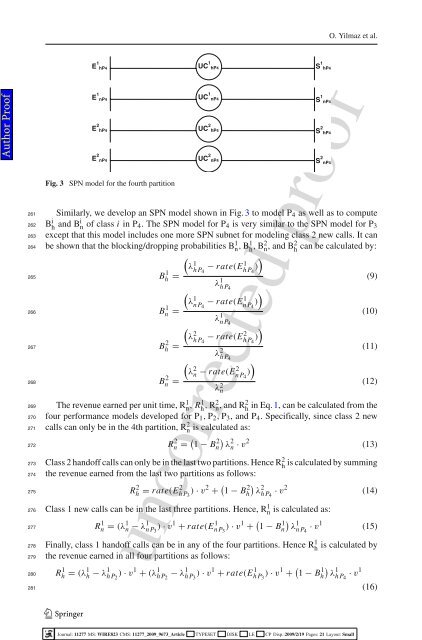Dear Author, Here are the proofs of your article. ⢠You can submit ...
Dear Author, Here are the proofs of your article. ⢠You can submit ...
Dear Author, Here are the proofs of your article. ⢠You can submit ...
- No tags were found...
You also want an ePaper? Increase the reach of your titles
YUMPU automatically turns print PDFs into web optimized ePapers that Google loves.
O. Yilmaz et al.E 1 hP4UC 1 hP4S 1 hP4<strong>Author</strong> Pro<strong>of</strong>E 1 nP4E 2 hP4E 2 nP4Fig. 3 SPN model for <strong>the</strong> fourth partitionUC 1 nP4UC 2 hP4UC 2 nP4261 Similarly, we develop an SPN model shown in Fig. 3 to model P 4 as well as to compute262 B i h and Bi n <strong>of</strong> class i in P 4. The SPN model for P 4 is very similar to <strong>the</strong> SPN model for P 3263 except that this model includes one more SPN subnet for modeling class 2 new calls. It <strong>can</strong>be shown that <strong>the</strong> blocking/dropping probabilities B 1 n , B1 h , B2 n ,andB2 h<strong>can</strong> be calculated by:()λ 1Bh 1 = hP 4− rate(EhP 1 4)265λ 1 (9)hP(4)λ 1Bn 1 = nP 4− rate(EnP 1 4)266λ 1 (10)nP(4)λ 2Bh 2 = hP 4− rate(EhP 2 4)267λ 2 (11)hP(4)λ 2Bn 2 = n − rate(E2 nP 4)268(12)The revenue earned per unit time, R 1 269 n , R1 h , R2 n ,andR2 hin Eq. 1, <strong>can</strong> be calculated from <strong>the</strong>270 four performance models developed for P 1 , P 2 , P 3 ,andP 4 . Specifically, since class 2 newcalls <strong>can</strong> only be in <strong>the</strong> 4th partition, R 2 271 n is calculated as:Rn 2 = ( 1 − Bn2 )λ2n · v 2 272(13)Class 2 hand<strong>of</strong>f calls <strong>can</strong> only be in <strong>the</strong> last two partitions. Hence R 2 273 his calculated by summing274 <strong>the</strong> revenue earned from <strong>the</strong> last two partitions as follows:275λ 2 nS 1 nP4S 2 hP4S 2 nP4R 2 h = rate(E2 hP 3) · v 2 + ( 1 − B 2 h)λ2hP4 · v 2 (14)276 Class 1 new calls <strong>can</strong> be in <strong>the</strong> last three partitions. Hence, R 1 n is calculated as:277Rn 1 = (λ1 n − λ1 nP 3) · v 1 + rate(EnP 1 3) · v 1 + ( 1 − Bn1 )λ1nP4 · v 1 (15)Finally, class 1 hand<strong>of</strong>f calls <strong>can</strong> be in any <strong>of</strong> <strong>the</strong> four partitions. Hence R 1 278 his calculated by279 <strong>the</strong> revenue earned in all four partitions as follows:Rh 1 = (λ1 h − λ1 hP 2) · v 1 + (λ 1 hP 2− λ 1 hP 3) · v 1 + rate(EhP 1 3) · v 1 + ( 1 − Bh1 )λ1hP4 · v 1280281(16)uncorrected pro<strong>of</strong>123Journal: 11277 MS: WIRE823 CMS: 11277_2009_9673_Article TYPESET DISK LE CP Disp.:2009/2/19 Pages: 21 Layout: Small
















